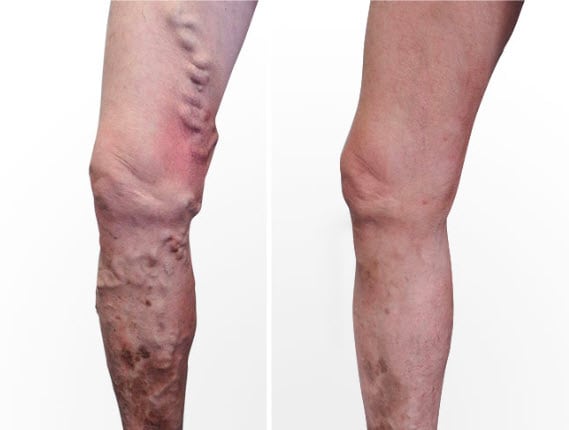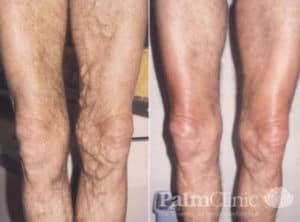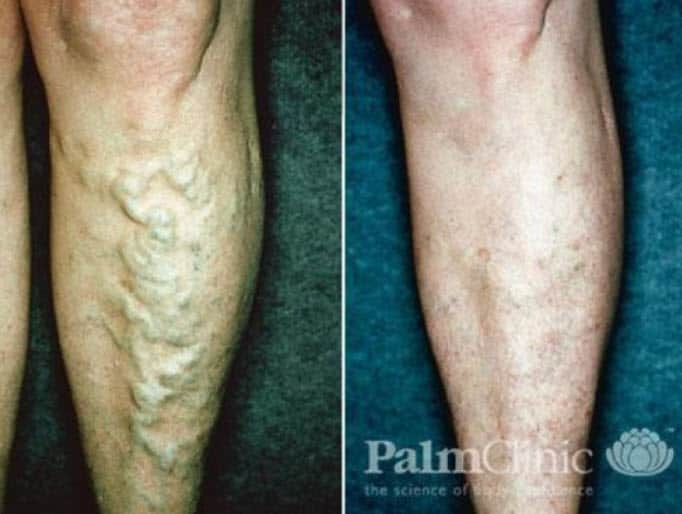Varicose Vein Treatments Explained | Palm Clinic NZ
At Palm Clinic, we employ two non-surgical varicose vein treatments, Radiofrequency Ablation (RFA) and Ultrasound Guided Sclerotherapy (UGS).
Each treatment caters to different needs and both are considered gold standard varicose vein treatment options. Below we explain the details and benefits of each treatment to help you understand whether these non-surgical varicose vein treatments are right for you.
We have successfully performed over 13,000 varicose vein treatments in the past 25 years. For more information on our treatments or to book an initial consultation, please contact our reception team.
Radiofrequency Ablation (RFA)
What is Radiofrequency Ablation
RFA is the gold standard non-surgical varicose vein treatment. A 2023 study reviewing over 7,400 treatments described RFA as “a high-performance method with few and often transient complications.”
Benefits of RFA Varicose Vein Treatment
Research shows that RFA is a safe and effective varicose vein treatment which is more successful and less painful than surgery. RFA is also clinically proven to be less painful than another leading non-surgical varicose vein treatment, EVLA. There is no GP referral required for this treatment.
Photos of before and after RFA varicose vein treatment at Palm Clinic NZ:

Drawbacks of RFA Varicose Vein Treatment
RFA can only be used on sections of the vein where the vessel is long, straight and wide. We therefore sometimes use a combination of RFA and UGS (explained below).
How RFA Works
RFA is mainly used for treating the proximal great saphenous vein (the section that runs in the inner thigh) and the upper small saphenous vein (the section in the upper calf).
After your initial consultation with the doctor, you will have an ultrasound map of your veins. This will measure the size of these two veins to determine if they are suitable for RFA.
During treatment, a local anaesthetic is used to make the procedure painless. A catheter is threaded up the vein under ultrasound guidance. As we retract the catheter, the tip is heated and this heat seals the vein behind it. This stops the vein from working therefore reducing swelling, pain and the bloated appearance of the varicose vein.
The entire procedure takes one to two hours.
Varicose Vein Treatment Healing Time
There is no down time after RFA in most cases. The majority of our patients are able to walk out of the clinic and go back to work if they choose.
After treatment we recommend you wear compression stockings, walk for 30 minutes twice a day and avoid strenuous exercise for two weeks.
Side Effects of RFA
It is common to have some bruising at the insertion site after treatment. It is also likely you’ll feel lumps in your leg but these will slowly fade over a few months.
Additionally there are exceedingly rare side effects including deep vein thrombosis and pulmonary embolism which your doctor will explain in detail during your initial consultation.
RFA Varicose Vein Treatment Cost
The cost of treatment will be discussed in full before treatment commences. Your varicose vein treatment cost may be covered by health insurance.
Ultrasound-Guided Sclerotherapy (UGS)
What is UGS
Ultrasound Guided Sclerotherapy (UGS) is a safe, effective, non-surgical varicose vein treatment that we have been performing for over 25 years.
Benefits of UGS Varicose Vein Treatment
When it comes to non-surgical varicose vein treatment, UGS is effective at treating smaller and more convoluted veins than RFA.
It is a fast procedure taking only around 10 minutes to perform with most patients returning to work within an hour. You don’t need a GP referral to seek UGS varicose vein treatment.
Photos of before and after UGS varicose vein treatment at Palm Clinic NZ:

Drawbacks of UGS Varicose Vein Treatment
UGS is not as effective at treating large veins as RFA and so it is often used in conjunction with RFA.
There is a limit to how much sclerosant or foam we can use safely in one day and this is why treatment is spread over a few days.
How It Works
UGS uses a medicine called sclerosant which is injected into the veins under ultrasound guidance so we can watch exactly where the medication is going.
The sclerosant causes inflammation in the vein walls causing them to compress and close. They are then cleverly reabsorbed by the body over a few months.
Blood is then diverted into the better functioning veins. The overall effect is an improvement in varicose veins symptoms such as heaviness, tired or swollen legs, or even skin changes such as lower leg eczema or ulcers.
You will also see the varicose veins disappear from sight over a few months.
UGS Varicose Vein Treatment Healing Time
You may experience bruising, tenderness or inflammation around the treated vein for a few weeks.
You will be recommended to wear compression stockings, walk daily and avoid strenuous exercise for two weeks.
UGS Side Effects
The possible side effects of this non-surgical varicose vein treatment will be discussed in detail at your initial consultation. These include brown staining on the legs (which is usually temporary), and incredibly rare instances of deep vein thrombosis or allergic reaction to the sclerosant.
Cost of UGS Varicose Vein Treatment
The varicose vein treatment cost will be determined by your doctor at the initial consultation and may be covered by health insurance.

